


These methods can conflict with one another. Giving priority to public transport might cause severe disruption to other vehicles. Slowing vehicles down appears to be in direct opposition to schemes to reduce vehicle delay. However, it was possible to design schemes that use these methods in a co-operative way. Making vehicles move with similar speeds can produce well behaved platoons that are more effectively controlled. Speeding the progress of public transport vehicles can also help private traffic.
An interface program has been produced to link the Italian simulation model NEMIS to the UK SCOOT system, allowing them to interact. Simulations have been carried out, using the appropriate interface, of the best strategies to find out their effects more accurately. These simulations suggest that synergy can be produced by combining appropriate strategy elements with significant reductions in travel time, vehicle operating costs, pollution emissions and accident rates being achieved.
The Italian SPOT UTC system and the UK SCOOT UTC system have been improved to let them carry out the most promising of the new ATT strategies. This includes the incorporation of a new inexpensive bus priority method.
An evaluation framework has been developed to allow consistent appraisal of both the simulations and the field trials and to allow comparisons with other DRIVE projects. This has been used to help draw up guidelines for other project's evaluation plans.
The SCOOT UTC system has been installed at the field trial site in Leeds at no cost to the project. Extra funding was obtained from the UK DOT to install the SPOT units in Leeds, along with special bus detection equipment, a speed violation camera and a VMS system. The Leeds bus operators have also purchased and installed the electronic tags for their fleet of buses. The UK EPSRC has also funded a project to look at the transferability of the PRIMAVERA techniques to other sites.
Permission was obtained to use the modified SPOT UTC system during the UK field trials. The SPOT system has been installed at ten intersections in Leeds and at seven intersections in Turin. An interface between the Italian SPOT system and UK signal controllers has been successfully developed and implemented. Permission was obtained from Turin City to use the AVM and UTC systems. All the trials in Leeds and Turin have been completed.
In the field of congestion management, it has increasingly been realised that computer based traffic control systems which rely on forward progression are inadequate in highly saturated conditions, because queues form which can disrupt upstream conditions and render forward progression infeasible. To overcome this, techniques for managing upstream queues, to ensure that they do not disrupt other movements, and for regulating, or gating, the input flows, have been developed. The literature includes a range of techniques applied in cities such as Athens, Bangkok, Paris, Graz, London, New York, Southampton and Turin. The main benefits arise in reductions in delay for counter-peak and crossing traffic. Such procedures are now available in the traffic signal control methodologies of several EC countries, but no consistent guidelines have been developed for their use. In most cases, these procedures operate in fixed time, but recent research has developed a real time gating technique based on parameters such as upstream flow, downstream occupancy and the extent of downstream queue storage space. Such real time techniques are important in treating highly volatile conditions which arise in over saturation, and in responding to incidents. Neither type of technique has yet been effectively integrated into the area wide traffic control strategies applied in city centres. In particular, such integration should permit morning peak demand on the centre to be regulated to ensure that it continues to operate in under-saturated conditions. In the evening peak the problem is more complex, since gating to ensure efficient operation of the radials can exacerbate city centre congestion. A range of fixed time and dynamic gating techniques in conjunction with the existing traffic responsive signal control strategies in operation in the case study cities were tested.
In the field of public transport priority, extensive use is made
of priority lanes, and their operation is well understood. However, they
lack flexibility in traffic control, and may be counterproductive in their
impact on the pedestrian environment. An alternative approach involves
selective detection of priority vehicles, which may, or may not be, specially
equipped. This approach provides for greater flexibility, and was tested
as part of the range of techniques considered. A third approach involves
modification of existing signal control strategies to provide greater weighting
to those routes which have higher flows of priority vehicles. This again
is an approach which is more flexible, although it may be disruptive to
routes which cross the case study corridor. Finally, there is the approach
of using gating techniques with priority for public transport. Most of
these have been applied as part of motorway access control, but there are
a few references in the literature to their use on urban arterials. The
first three of these approaches are already in widespread use in Europe,
and will be further developed as part of an overall strategy of public
transport enhancement in DRIVE II. In our project, we tested the full range
of these methods, by simulating their incorporation into existing signal
control strategies. However, it was necessary to develop them further by
considering their interaction with the gating techniques outlined above.
It will be clear that gating could be disruptive to public transport unless
it took place on approaches not used by public transport or it enabled
public transport to bypass the resulting queues. Opportunities for these
alternative ways of integrating the two approaches were evaluated. The
first stage in this area was to produce a review of the current state of
the art in public transport priority, including both physical measures
(busways, bus lanes etc) and techniques involving priority at traffic signals
(biased offsets, stream weighting, selective vehicle detection etc).
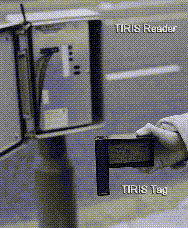 |
In the field of traffic calming, many of the developments have been in physical redesign of minor roads in residential and shopping areas. To an extent, these measures have aggravated conditions on the main radials, by transferring traffic back to them. More recently, attention has switched to those main urban roads, from which it is difficult to divert traffic. Traffic calming techniques have been developed which concentrate on keeping traffic moving, so that queues, and their resulting emissions, are not formed, while ensuring that traffic moves slowly, thus avoiding undue risk to pedestrians and other road users. Again, most of the measures have been physical, but signal control techniques have also been developed, in which platoons of traffic are formed and allowed to pass slowly through the environmentally sensitive area, with sufficient headway between them to enable pedestrians to cross. These approaches are still at a conceptual stage, and have yet to be tested in practice. In particular, they have only been simulated in fixed time operation, while in practice they will need to perform effectively under varying conditions and in response to incidents. As a result, little is known of their actual impact on the environment, or of road users' reactions to them. Moreover, it is possible that such signal control techniques could conflict with the need to provide priority to public transport, or to gate other traffic. The project has both tested these platooning techniques further, and investigated the potential conflicts between them and the related techniques for congestion management and for public transport priority.
A comprehensive review of traffic calming techniques introduced throughout Europe has been carried out by HETS with assistance from ITS, with the knowledge that these are much more advanced in some parts of the EC than others. This report forms Deliverable No. 3.
Traffic calming measures on both Dewsbury Road and the adjacent residential areas have been developed. Emphasis was given to control using traffic signals with only minor physical modifications on the arterial. A speed violation camera has been installed on the Dewsbury Road, combined with a VMS system to warn drivers if they are travelling too fast. If they fail to heed the warning given by the sign then the camera takes a picture of the vehicle and the driver is prosecuted.
As an example, the SPOT system has been modified to implement a new gating strategy, which we have called auto-gating. Under a fixed time plan, unexpected traffic conditions can easily result in queues that cause excessive disruption when they begin to block upstream junctions. Recent approaches have tried to solve this problem by using a gating action to store vehicles upstream of a critical bottleneck, in a pre-determined section of road with plenty of storage capacity. Auto-gating or metering is a new form of gating whereby each link stores vehicles without blocking-back. This is achieved by funnelling the green times according to the downstream queues or space left.
A new queue evolution model, called the horizontal queue evolution model, presented in Primavera Deliverable 8, is used by the SPOT optimisation algorithm to forecast the evolution of the downstream queue as a function of the releases provided by different traffic light control strategies. This, together with information about the storage capacity of downstream approaches, permits the system to detect oversaturation conditions and to react through a gating action. Other methods of implementing auto-gating strategies with both SPOT and SCOOT have also been developed.
The interface package is installed on a MS-DOS PC connected by a serial
line with the NEMIS computer and by another serial line with the WYHETS
SCOOT system located in Leeds as shown in the following diagram.
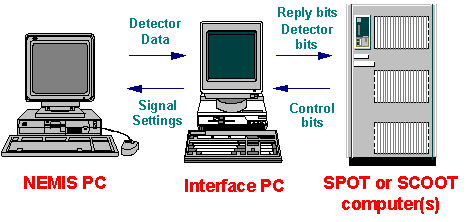 |
The SCOOT system computer is a FERRANTI 700 industrial computer, the hardware interface provided by the SCOOT computer is a standard RS232 serial interface working at 1200 baud. The NEMIS computer is a 486 computer working at 33MHz under the OS/2 operating system, the hardware interface is a RS232 working at 9600 baud or 4800 baud. The interface computer is a 386/40MHz MS-DOS machine with two RS232 serial ports. The software interface package is based on the FRONTEND package produced by MIZAR currently used to interface the NEMIS package with a network of SPOT units.
The FRONTEND package software, written in the C language, is able to simulate a multitasking operating system and can communicate on several serial ports at the same time and with different speeds. The NEMIS software package is written in the FORTRAN language.
For these purposes NEMIS was able to receive, in real time, control strings for the traffic lights and to send back measures of counting sensors located on the network in the format required by the SCOOT system.
A standard set of impact parameters were used. The expected benefits
on each of these impacts are given in Table 1 below. Table 2 shows how
each of these impacts were measured during the field trials. Full details
of the evaluation framework can be found in Deliverable No. 11. This includes
a full statistical analysis giving the likely sample size required to measure
the expected benefits and a detailed field trial plan for each city.
| Impact Variable | Expected Benefit |
|---|---|
| Journey Time | Reduction in overall journey time or maintained journey time with reduced variability. Benefits expected from generally more controlled speeds through the system. |
| Vehicle Operating Cost | Reduced operating costs gained from fewer oversaturated junctions and reduced number of stops. |
| Comfort | Increased comfort as reflected in fewer (unscheduled) stops and benefits from reduced congestion. |
| Safety | Increased safety levels as a benefit of lower and more controlled speeds of vehicles. |
| Air and Noise Pollution | Reduced estimated pollution levels as a benefit of reduced congestion, fewer unscheduled stops and controlled speeds through the system. |
| Crossing delay, Uncertainty, Visual Intrusion and Severance | Reduced levels in each of these impact variables as a benefit of reduced congestion, lower and more controlled vehicle speeds. |
| Stress | Reduced driver stress as a benefit of reduced congestion and more controlled speeds. Reduced resident stress as a benefit of reduced and controlled speeds, reduced estimated noise/pollution and reduced crossing delays. |
| Traffic Flows | Traffic flows may be seen to increase overall as more vehicles move more efficiently through the system. However this should not occur at the cost of other impact variables such as journey time. |
| Vehicle Occupancy | Whilst little or no change may be expected in car occupancy, bus occupancy may be expected to increase as a response to the benefits of PT/ATT measures. |
| VARIABLE | DISAGGREGATE IMPACT GROUP | SAMPLING FRAME | COSTABILITY (UNITS) |
|---|---|---|---|
| Journey Time | Vehicle Category (total 5) - cyclist, car, bus, light commercial, heavy
commercial
Pedestrian: people category age/ability |
Before study - 12 days, 193 runs by Moving Observer. 16 routes surveyed on 1 day. Hours 0800 - 0900, 1500 - 1600, 1700- 1800. 6 runs/hr each direction. After study the same + licence plate matching. Extra information available from Bus Survey. | Minutes |
| Vehicle Operating Cost | Vehicle Category (excluding cyclist) - car, bus, light commercial, heavy commercial | Not surveyed in before study. Questionnaire to drivers/bus operators
|
£/ECU |
| Comfort | Bus/car by people category: age/ability | Not surveyed in before study. Will use "number of stops" data as a surrogate | Multicriteria Form (MCF) or No of Stops |
| Safety | May be too small to disag. by people cat. Severity - slight/serious/fatal | Before study - all accidents in study area 1/1/87 to 1/1/92
After study - Conflict analysis |
No and severity of conflicts. |
| Air and Noise Pollution | Residents, Pedestrian, Cyclist Groups | Not to be surveyed in the field - use Simulation Study (NEMIS) | MCF |
| Crossing Delay | People categories age/ability/visiting | Complete pedestrian survey carried out for before study.
Simulation + small field surveys for after study. |
Minutes or MCF |
| Stress | Residents, Pedestrians: age/ability/visiting
Drivers: vehicle category |
Questionnaires to resident categories. Could use traffic density, noise and pollution as estimates (waiting time / traffic speed / traffic flow for residents) | MCF |
| Traffic Flows | Vehicle category | Before study as follows:
ATC's - 11 sites, both directions, 15 mins, 1 month (March 1992) MCC's + Junction. 1 weekday. 0700-1000, 1500-1800. 15 mins (information collected for 7 vehicle types) Subsid. MCC's on minor roads. Left/right turn 0700-1000, 1500-1800. 1 weekday. 15 mins (3 vehicle types collected) All before surveys - TUES/WED/THURS 3/92. After survey, same data (June-Oct 1994) + Extra bus information. |
Total vehicles otherwise MCF |
| Vehicle Occupancy | Cars/Buses | Not surveyed in before study - Use field survey | People Numbers |
| Scheme Cost | - | - | CBA/£/ECU |
Both a Cost-Benefit approach and a Multi-Criteria method have been used
to assess the simulations. In the Cost Benefit Analysis (CBA) monetary
values have to be given to each impact evaluated. The rates used are those
given in the DRIVE I EVA manual, they are as follows:
| Impact | Cost |
|---|---|
| Travel Time (UK) | 14.26 ECU/person hour |
| Travel Time (Italy) | 18.28 ECU/person hour |
| Fuel Consumption | 0.36 ECU/l |
| CO Emissions | 3 ECU/ton |
| NOx Emissions | 443 ECU/ton |
| Hydrocarbon Emissions | 348 ECU/ton |
| Fatal Casualty | 744,177 ECU |
| Serious Casualty | 105,593 ECU |
| Slight Casualty | 7,080 ECU |
For the Multi-Criteria Analysis (MCA) two different sets of weights
were used, as shown in Table 4. The analysis has been carried out using
the MASCOT program, which comes with three sets of weights built-in that
reflect the opinions of the values of "Official", "Environmental" and "Commercial"
groups. This set of weights has been supplemented by some additional values
for impacts not originally considered. As the results of the "Commercial"
weights are very similar to those using the "Official" weights, only the
"Official" and "Environmental" weights are considered here.
| Impact | Units | Target %change | Official Weights | Environmental Weights |
|---|---|---|---|---|
| EFFICIENCY | ||||
| Car travel time saving | k veh s | -15 | 5.5455 | 3.0248 |
| Bus travel time saving | k veh s | -5 | 138.6388 | 106.645 |
| Travel time sd reduction | k veh s | -15 | 2.7728 | 1.5124 |
| Bus time sd reduction | k veh s | -10 | 69.3194 | 53.3225 |
| Stops | k | -10 | 0 | 100 |
| Speed sd | m/s | -1 | 0 | -0.3 |
| ENVIRONMENT | ||||
| Fuel consumption saving | k litres | -5 | 360 | 3600 |
| NOx emissions | kg | -10 | -0.443 | -4.43 |
| HC emissions | kg | -10 | -0.348 | -3.48 |
| CO emissions | kg | -10 | -0.003 | -0.03 |
| Visual intrusion by queues | veh | -10 | 10 | 15 |
| SAFETY | ||||
| Mean speed | m/s | 0 | 0 | -10 |
| Excessive speed time | k s | -5 | 0 | 50 |
| Fatal casualty reduction | Casualties | -5 | 744177 | 1284910 |
| Serious casualty reduction | Casualties | -5 | 105593 | 211186 |
| Slight casualty reduction | Casualties | -5 | 7080 | 12390 |
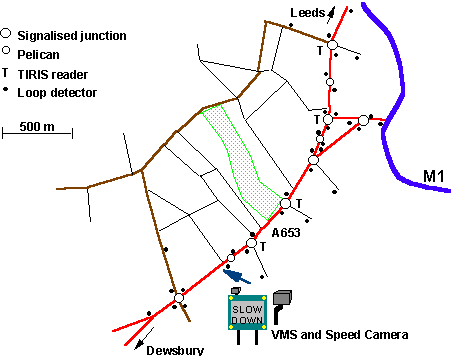 |
| Strategy code | Strategy name |
|---|---|
| Q | Horizontal Queue Model |
| A1 | Auto-gating 1 - The MX strategy |
| A2 | Auto-gating 2 - Local Feedback Control |
| B | Bus priority with TIRIS |
| S | Speed Advice |
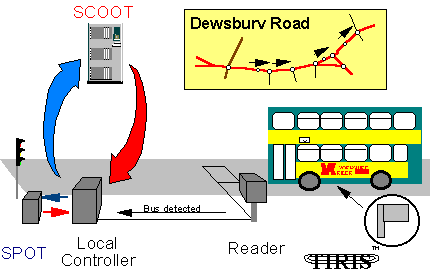 |
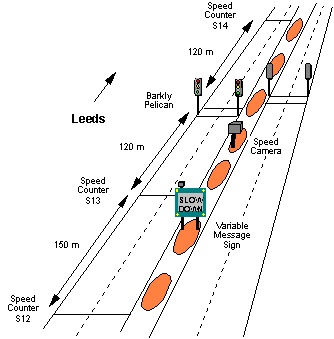 |
Table 6 contains the % change in the impact over the base case. The
travel times of the bus services given priority treatment (Bus TT) are
also shown.
| Impact | Q+S | Q+B | B+S | Q+B+S |
|---|---|---|---|---|
| Mean Speed (m/s) | 2.27 | 1.08 | 2.49 | 3.06 |
| Speeding Time (s) | -8.24 | 0.91 | -7.94 | -8.18 |
| Blocking Back (s) | 5.39 | 17.22 | 32.37 | 6.74 |
| Stops (veh) | -1.67 | -0.73 | -2.46 | -1.64 |
| Delays (s) | -1.13 | -1.28 | -2.45 | -4.33 |
| Travel Time (s) | -2.26 | -1.22 | -2.44 | -2.95 |
| Fuel Consumption (l) | -0.79 | -0.38 | -1.06 | -1.02 |
| CO Emissions (g) | -1.81 | -1.17 | -2.40 | -2.66 |
| NOx Emissions (g) | -1.04 | -0.78 | -1.54 | -1.76 |
| HC Emissions (g) | -1.68 | -1.08 | -2.01 | -2.38 |
| Bus Travel Time (s) | -2.10 | -1.21 | -1.50 | -1.66 |
| Bus Time Route 2 (s) | -2.23 | -4.32 | -2.96 | -2.75 |
| Bus Time Route 24 (s) | 0.38 | 1.46 | 2.51 | -1.85 |
| Bus Time Route 46 (s) | -3.07 | -2.83 | -1.49 | -2.07 |
Table 7 indicates the results of the CBA. All values refer to the two
hour AM peak data collection period. All the monetary values are in ECU.
The rates used for the CBA can be found in Table 3. For the SPOT based
strategies in the AM Peak, the integrated strategy containing the Horizontal
Queue Model, bus detection with TIRIS and Speed Advice using VMS is easily
the most beneficial integrated strategy. Giving priority to buses always
improves a strategy when combined with other components.
| Strategy | % Benefit over standard SPOT |
|---|---|
| B | 3.28 |
| Q + B + S | 1.88 |
| Q + S | 1.69 |
| B + S | 1.63 |
| Q + B | 1.00 |
| Q | 0.41 |
| S | -1.17 |
| A1 | -1.35 |
| A2 | -2.47 |
The travel time figures dominate the costs associated with each strategy.
Typically they are about ten times larger than the accident costs, twenty
times larger than the fuel costs and a thousand times larger than the pollution
emission costs. The CBA will therefore favour strategies which reduce travel
time, with little regard for environmental or safety factors. Safety is
a problem on the Dewsbury Road, having an accident rate of nearly double
the national average for roads of its type. The CBA does not adequately
reflect any improvements in safety. For this reason, the MCA is preferred.
A multi-criteria analysis has been carried out using the MASCOT program.
This program comes with three sets of weights built-in that reflect the
opinions of the values of "Official", "Environmental" and "Commercial"
groups. This set of weights has been supplemented by some additional values
for impacts not originally considered. As the results of the "Commercial"
weights are very similar to those using the "Official" weights, only the
"Official" weights are considered here. The weights and targets used can
be found in Table 4.
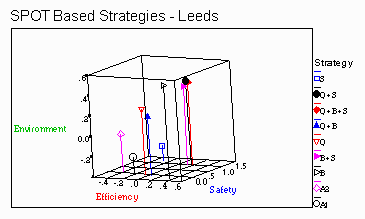 |
For the SPOT based strategies the Q+B+S strategy comes out on top when using the "Environmental" weights and second with the "Official" weights. There is a cluster of strategies which are all good on safety, efficiency and the environment, these being Q+S, B+S and Q+B+S. For all the strategies, integration with Speed Advice improves safety without adversely affecting efficiency or the environment. Integration with bus priority does not have much effect. A sensitivity analysis has been carried out which reveals that it is very difficult to remove Q+B+S from its top position by changing the weights. The most likely change is to reduce the excessive speed weight by a factor of three, which puts the B strategy on top. Changes in scores can also change the rankings, however within the uncertainties associated with each score it is only possible to get either Q+S or B+S to replace Q+B+S as the top strategy.
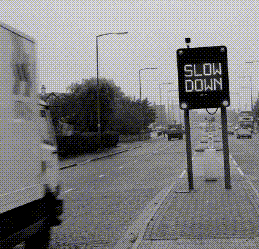 |
Leeds
 |
The main improvements deduced due to adoption of the PRIMAVERA strategies in Leeds are:

Reviews of the current state of the art in Queue Management techniques, Public Transport priority techniques and Traffic Calming techniques have been produced.
The consortium decided to develop and install a low cost bus priority system based on TIRIS transponders as part of the field trials in Leeds. Leeds City Council obtained funding and installed the necessary loop detectors and TIRIS readers at four junctions on the Dewsbury Road. The main bus operators have installed the TIRIS transponders on their fleets of buses at their own expense. The system has performed successfully during the Leeds field trials.
Funding was obtained and the VMS equipment and an automatic speed violation camera were installed on Dewsbury Road, Leeds. The system has performed successfully during the Leeds field trials.
The SCOOT UTC system has been successfully interfaced with the NEMIS simulation model and tested satisfactorily. Enhancements have been made to the SCOOT software to allow it to implement the new queue management and bus priority strategies developed by PRIMAVERA. The field trial networks in Leeds and Turin have been coded into the NEMIS model and successfully calibrated against real data. Simulations of the new integrated strategies have been performed and evaluated.
The SPOT system has been modified to incorporate a new "Look Ahead Cost" to enhance recovery from saturated conditions and a new model for horizontal queue evolution has been developed for the new auto-gating strategy. It has also been modified so that it can implement other auto-gating strategies and give priority to buses via the TIRIS tagging system in Leeds. Innovative strategies for ATT traffic calming and bus stop protection have been developed and incorporated into the SPOT system. An interface between the SPOT units and UK local controllers has been successfully developed to allow SPOT to control UK signals. The new system has successfully operated during the Leeds field trials.
The report of the extensive 'before' surveys carried out in Leeds and Turin has been produced. This has been used in the model calibration. An evaluation framework has been produced that allows efficiency, safety and environmental benefits to be measured. This has been used to evaluate both the simulations and the field trials. The evaluation framework has been used by the Urban Traffic Management and Information Task Force as a basis for recommendations for other DRIVE II projects. Extensive surveys of the best SPOT based and SCOOT based strategies in Leeds have been carried out, and similar surveys for the SPOT system have been completed in Turin.
A best practice manual has been produced which gives guidelines on the design and evaluation of integrated strategies.
In their latest transport plan, Leeds City Council are recommending that the techniques developed by PRIMAVERA are used on other radial routes in the city. This reflects the close cooperation between the project and the cities.
| Reference Number | Title |
|---|---|
| 1 | Review of queue management strategies |
| 2 | Features of public transport priority systems |
| 3 | Review of traffic calming techniques |
| 4 | Description of Field Trial Sites |
| 5 | Letter from Turin City |
| 6 | Supplement to Deliverable 2 |
| 7 | Implementation Specifications |
| 8 | Implementation Aspects |
| 9 | Initial Simulation Results |
| 10 | Specification of Integrated Strategies |
| 11 | Evaluation Methodology |
| 12 | Evaluation of Simulated Strategies |
| 13 | Field Trials implementation and data collection |
| 14 | Report on preliminary analysis of field trials |
| 15 | Overall evaluation of field trials and recommendations for Europe |
| Year | Event or Publisher | Title of Paper | Authors | Partners |
|---|---|---|---|---|
| 1995 | Traffic Engineering and Control Vol 36 No 11 | Integrated ATT strategies for urban arterials: DRIVE II project PRIMAVERA Part 4: The Corso Grosseto Experiment | Biora F | MIZAR |
| 1995 | Traffic Engineering and Control Vol 36 No 7 | Integrated ATT strategies for urban arterials: DRIVE II project PRIMAVERA Part 3: The Dewsbury Road Experiment | Fox KA, Montgomery FO, Balmforth P, Franklin P, Siu YL and Heywood R | ITS and HETS |
| 1995 | Traffic Engineering and Control Vol 36 No 6 | Integrated ATT strategies for urban arterials: DRIVE II project PRIMAVERA. Part 2: Bus Priority in SCOOT and SPOT using TIRIS | Fox KA, Montgomery FO, Shepherd SP, Smith C, Jones S and Biora F | ITS, PEEK, HETS and MIZAR |
| 1995 | Traffic Engineering and Control Vol 36 No 5 | Integrated ATT strategies for urban arterials: DRIVE II project PRIMAVERA Part 1: Overview | Fox K, Montgomery FO, May AD | ITS |
| 1995 | Fourth International Conference on the application of advanced technologies in Transportation Engineering, Capri, Italy, 27th. - 30th. June 1995 | A Best Practice Manual for Innovative UTC Systems | Montgomery FO, May AD, Fox KA, Biora F, Mauro V and Jones S | ITS, MIZAR and HETS |
| 1995 | Fourth International Conference on the application of advanced technologies in Transportation Engineering, Capri, Italy, 27th. - 30th. June 1995 | Integrated ATT strategies for Urban Arterials | Montgomery FO, May AD, Fox KA, Biora F, Mauro V and Jones S | ITS, MIZAR and HETS |
| 1994 | Workshop on Improvements of Energy Efficiency in Urban Transport Networks | Current Experiences in Public Transport Priority and Trends | Fox KA, Clark SD, Lanteri F, Biora F, Conte S | ITS and MIZAR |
| 1994 | EURO XIII / OR 36 Conference. University of Strathclyde | Evaluation of integrated ATT strategies for urban arterials | Montgomery FO and Fox KA | ITS |
| 1994 | OR Insight Volume 7, Issue 2. April-June 1994 | Giving Benefit to Buses | Clark SD and Pretty RL | ITS |
| 1994 | CETTEC 94, St. Patrick's College, Maynooth, Ireland. 8-9 September 1994. | Design of Integrated ATT Strategies for Arterial Routes | Biora F, Clark SD, Fox KA and Montgomery FO | MIZAR and ITS |
| 1994 | World Congress, Paris November-December 1994 | PRIMAVERA: Integrated ATT strategies for urban arterials | Biora F, Fox KA and Montgomery FO | MIZAR and ITS |
| 1994 | World Congress, Paris November-December 1994 | PRIMAVERA: A Best Practice Manual for Innovative UTC Schemes | Montgomery FO and Biora F | MIZAR and ITS |
| 1993 | Institute for Transport Studies - Technical Note No.s 328/329 | Collection, Analysis and Interpretation of Bus Survey Data for use in a micro-simulation package. | Clark SD | ITS |
| 1993 | Drive Technical Days Meeting, Brussels. | Primavera Project - Initial Simulation Results | Clark SD and Montgomery FO | ITS |
| 1993 | Universities Transport Studies Group Conference | The Evaluation of Management Strategies for the Leeds Test Site | Fox KA, Pretty RL, Shepherd SP and Clark SD | ITS |
| 1993 | Applications of Advanced Technologies in Transportation Engineering | Metering Strategies Applied to Signalized Networks | Shepherd SP | ITS |
| 1992 | Traffic Engineering and Control Vol 33 No 11 | A Review of Queue Management Strategies | Quinn DJ | HETS |
| 1992 | Conference on Vehicle Navigation and Information Systems | Integrated Traffic Control on Urban Arterials | Bolelli A and Montgomery FO | MIZAR and ITS |
 PRIMAVERA
Home Page
PRIMAVERA
Home Page
 PRIMAVERA
End Products
PRIMAVERA
End Products
 ITS
home page
ITS
home page